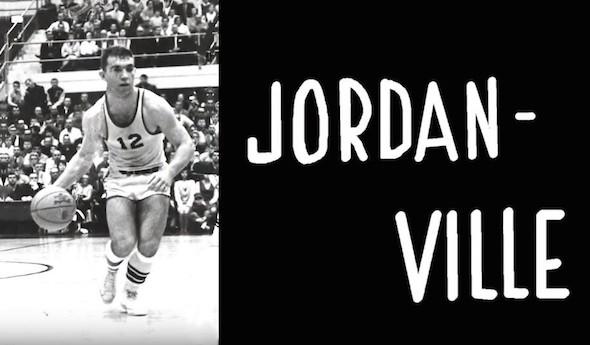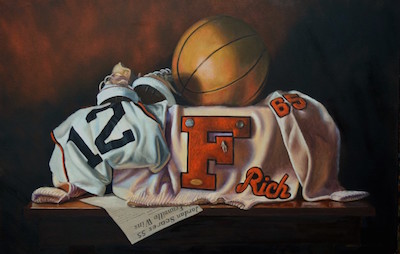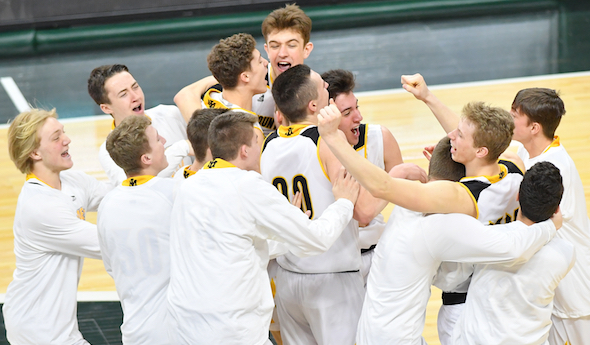
Film Fills In Picture of 'Fennville Flash'
By
Ron Pesch
MHSAA historian
December 28, 2017
We’ve been here before, but not in this way.
The last time was for a retrospective, covering one of the most impressive and awe-inspiring prep careers in Michigan high school history. That time was in print, and included a handful of still images that tried to illustrate the unbelievable.
But this time, the story is in documentary form. It’s woven together from grainy, scratched, faded silent film, a format of capturing memories familiar to thousands of people from generations past, as well as a series of modern-day high-resolution interviews.
Here, the basketball life of the athlete known as the “Fennville Flash” delivers on many levels. Yes, there is a Richie Jordan.
JordanVille, a documentary by John Mooy & Anne Colton, recalls a time when legend spread via word of mouth, newsprint and AM radio.
While it’s hard to comprehend for many today, the exploits of our athletic heroes were formed by “poets in the press box” who sat with pencil and paper, a typewriter, a microphone or a telephone, and described to their audience what they witnessed. On the receiving end, readers and listeners conjured up visualizations based on the facts, phrases and superlatives designed to create an image.
“Traveling left to right on your radio dial” helped listeners feel they were a member of the crowd, seated in the stands, in on the action and a witness to the mayhem. “Packed to the rafters,” reminded fans the importance of what was happening. An exciting game, presented by those with skill, created an event you longed to see. If a broadcast couldn’t be picked up on a transistor or tube radio, the final result might not be known, at the earliest, until the following day’s newspaper arrived.
I’ve told Jordan’s story via the MHSAA before; how he latched on to athletic training, weights and repetition to mold himself into a well-rounded athlete, able to leap to heights unexpected for a kid with a 5-foot-7 frame. The tales of his unfathomable accomplishments slowly leaked beyond the city limits of Fennville into Kalamazoo and greater Southwestern Michigan, then to Detroit. When Detroit Free Press writer Hal Schram relayed Jordan’s feats, the secret traveled across the state and beyond its drawn borders.
From there the legend of Jordan’s accomplishments grew. In Fennville, as in many small towns across the country, the city shut down when a game was played. The Jordan story was so enticing that thousands would travel vast distances to see him play with their own eyes. Today, his single season scoring average of 44.4 points per game during the 1964-65 campaign still remains the top mark in the MHSAA record book.
 JordanVille runs just shy of a half hour. Contained within is insight into the athlete that is challenging to relay in print form. Thanks to access to home movies and a series of interviews with Jordan, former teammates, past opponents and his high school coach, the determination, dedication and drive of a kid who wouldn’t let physical size be a deterrent from achievement radiates from the screen. On display is small town America at its finest, and perspective formed over 50+ years.
JordanVille runs just shy of a half hour. Contained within is insight into the athlete that is challenging to relay in print form. Thanks to access to home movies and a series of interviews with Jordan, former teammates, past opponents and his high school coach, the determination, dedication and drive of a kid who wouldn’t let physical size be a deterrent from achievement radiates from the screen. On display is small town America at its finest, and perspective formed over 50+ years.
For Mooy, it completes a filmmaking journey started six years ago. But the story of Jordan, in his eyes, date back to his school days. Mooy first heard about Jordan as a 7th-grader from a math teacher. A second-team all-St. Joseph Valley League selection, Mooy played at Marcellus High School and scrimmaged against Jordan and the Fennville Blackhawks.
He couldn’t believe his eyes.
“Everyone wanted to see this kid play,” said Mooy in 2011. “He was the first high school player I saw sign an autograph.
Today, with the interviews complete, and the film ready for viewing, Mooy sees more than just a sports story:
“With the benefit of years now passed, I look at the Rich Jordan story with a new respect. JordanVille created a place that was welcoming no matter who you were, or what color your skin happened to be. It was the 1960s. Rich was growing up Jewish, the Civil Rights Movement was in full swing, and the Vietnam War was on everyone's mind. And in Fennville, Michigan, from 1961 to 1965, the Jordan high school years, there were lessons beyond sports being learned by everyone that would last a lifetime. The Jordan household, under the guidance of (his parents) Tuffy and Sylvia Jordan, is where the story begins."
The film speaks of a time that has departed. Competition for our attention was less focused; phones hung on walls or sat on tabletops, communities were tighter, the training table featured peanut butter and chocolate milk instead of protein powder. A city could easily be renamed for a day.
The film also reminds us that those days were far from perfect.
If all goes as planned, the public will see the finished product come the flip of the calendar. In West Michigan, JordanVille is scheduled to show on New Year’s Day at 6 p.m. on WGVU, and will repeat on WGVU-Life at 7:30 p.m., Friday, Jan. 5.
Seek it out, and spread the word, just like in days of old.
 Ron Pesch has taken an active role in researching the history of MHSAA events since 1985 and began writing for MHSAA Finals programs in 1986, adding additional features and "flashbacks" in 1992. He inherited the title of MHSAA historian from the late Dick Kishpaugh following the 1993-94 school year, and resides in Muskegon. Contact him at [email protected] with ideas for historical articles.
Ron Pesch has taken an active role in researching the history of MHSAA events since 1985 and began writing for MHSAA Finals programs in 1986, adding additional features and "flashbacks" in 1992. He inherited the title of MHSAA historian from the late Dick Kishpaugh following the 1993-94 school year, and resides in Muskegon. Contact him at [email protected] with ideas for historical articles.
PHOTOS: (Top) Richie Jordan runs Fennville's offense during his thrilling high school career in the 1960s. (Middle) Jordan memorabilia, as captured by Bill Williams.

Iron Mountain Dream Season Continues
March 14, 2019
By Geoff Kimmerly
Second Half editor
EAST LANSING – “Living this dream.”
Iron Mountain coach Bucky Johnson put special emphasis on those words Thursday afternoon.
He may have been pointing out the present tense of “living” after his Mountaineers ended the season for 2018 Class C champion Detroit Edison. Or maybe the “dream” as his team earned a shot to play for its first MHSAA boys basketball championship since winning the Upper Peninsula-only bracket in 1939.
Iron Mountain faced a tall task in the day’s first Division 3 Semifinal, even for a team that hasn’t tasted defeat this season. But the Mountaineers held off Edison 60-57 in their first Semifinals appearance since 1994.
“There’s not a lot of U.P. teams that get to come down here and experience this,” Iron Mountain junior guard Foster Wonders said. “To come down here and win too is something special. We take pride in that. It’s been unbelievable.”
Iron Mountain (27-0) will face also-unbeaten Pewamo-Westphalia in Saturday’s 4:30 p.m. championship game.
The Mountaineers have enjoyed quite a visit to East Lansing. On Wednesday, they spent an hour with 1973 graduate Tom Izzo, then watched his Michigan State team practice Thursday morning.
And all of that set up the Semifinal they weren’t necessarily expected to win – despite the perfect record they brought downstate. Edison (18-9) had more losses than all but one team making the trip to Breslin this weekend, but all seven to in-state opponents had come against Division 1 and 2 teams, and the Pioneers had just toppled top-ranked Flint Beecher in their Quarterfinal.
Edison then led most of the first quarter, carrying a seven-point advantage into the second.
“In the U.P. you don’t really see any athletes like that, with the length and athleticism they had,” Iron Mountain junior guard Marcus Johnson said.
 But he and his teammates had a few surprises for Edison as well.
But he and his teammates had a few surprises for Edison as well.
First was a game plan to attack the paint, which resulted in two first-quarter fouls for Pioneers’ 6-foot-6 junior Bryce George. He ended up limited to only 15 minutes for the game, with eight points and six rebounds that could’ve been a lot more with more time on the floor. He had four points and four rebounds before picking up that second foul 5:11 into the game.
Next, Iron Mountain played only six players, and four all 32 minutes. Edison had 12 players with at least four minutes of action, but couldn’t wear the Mountaineers down.
Not surprising was how Iron Mountain won. Johnson was averaging 23.3 points per game entering this week, and sophomore guard Foster Wonders was averaging 23.9. Wonders had 28 on Thursday, making nearly half his shots from the floor and 9-of-10 free-throw tries. Johnson had 23 points, with five 3-pointers and perfection on six free-throw attempts.
“One thing we knew about this team is they were winners. If a team has gone all season not losing a basketball, game, you have to respect them to the utmost,” Edison coach Brandon Neely said. “These guys play six guys, and one guy played four minutes. The thing about this team is they play so well as a team because they know where guys are. Teams like that are a great example to learn from.
“They played like champions.”
Sophomore guard Ralph Johnson came off the bench to lead Edison with 14 points, and senior forward Brian Taylor was held to 11 points and seven rebounds. Taylor, the team’s leading scorer coming into this week, was also its lone senior this season.
Edison shot a game-high 47 percent from the floor during the fourth quarter and got within 45-44 with 3:26 to play. But Iron Mountain’s “makers” – as Bucky Johnson called them, spinning off the “shooters shoot” phrase – had connected on 64 percent of their shots during the third quarter and made 50 percent during the fourth, including both shots from the floor and 10 straight free throws after Edison pulled within a point.
“Coach Izzo told us some people like it, some people love it and some people live it,” Marcus Johnson said. “And we want to live it. It’s an awesome feeling to get to the championship, and we want to get it home.”
PHOTOS: (Top) Iron Mountain celebrates Thursday its first Semifinal win since 1939. (Middle) Jake Dumais (32) battles Edison’s Brian Taylor for a loose ball.

